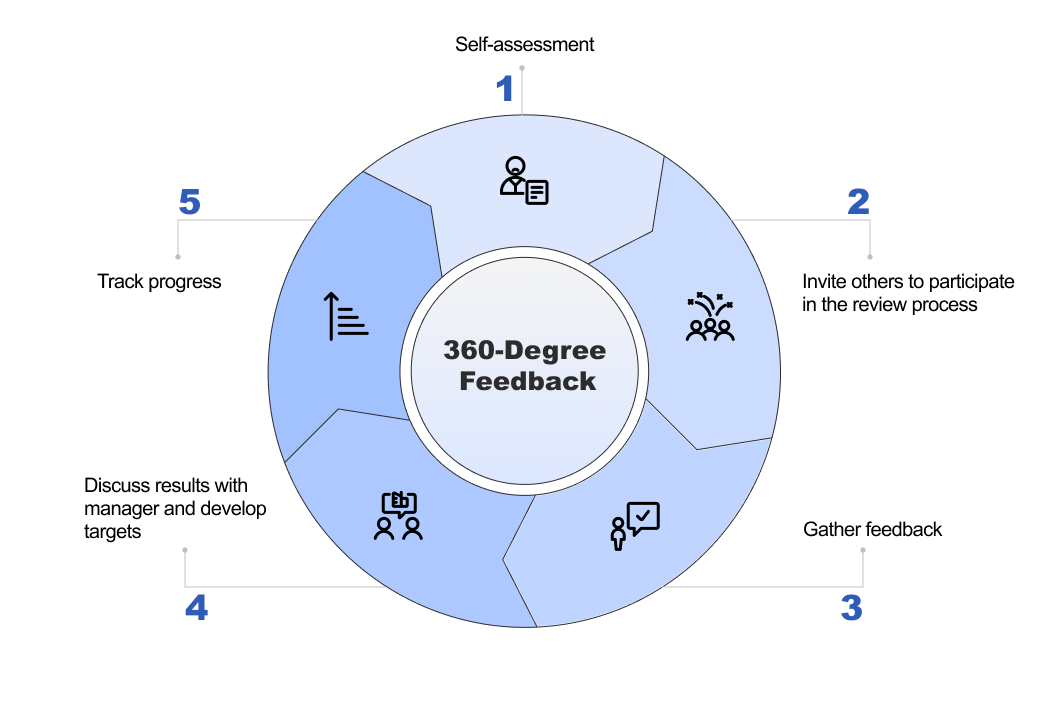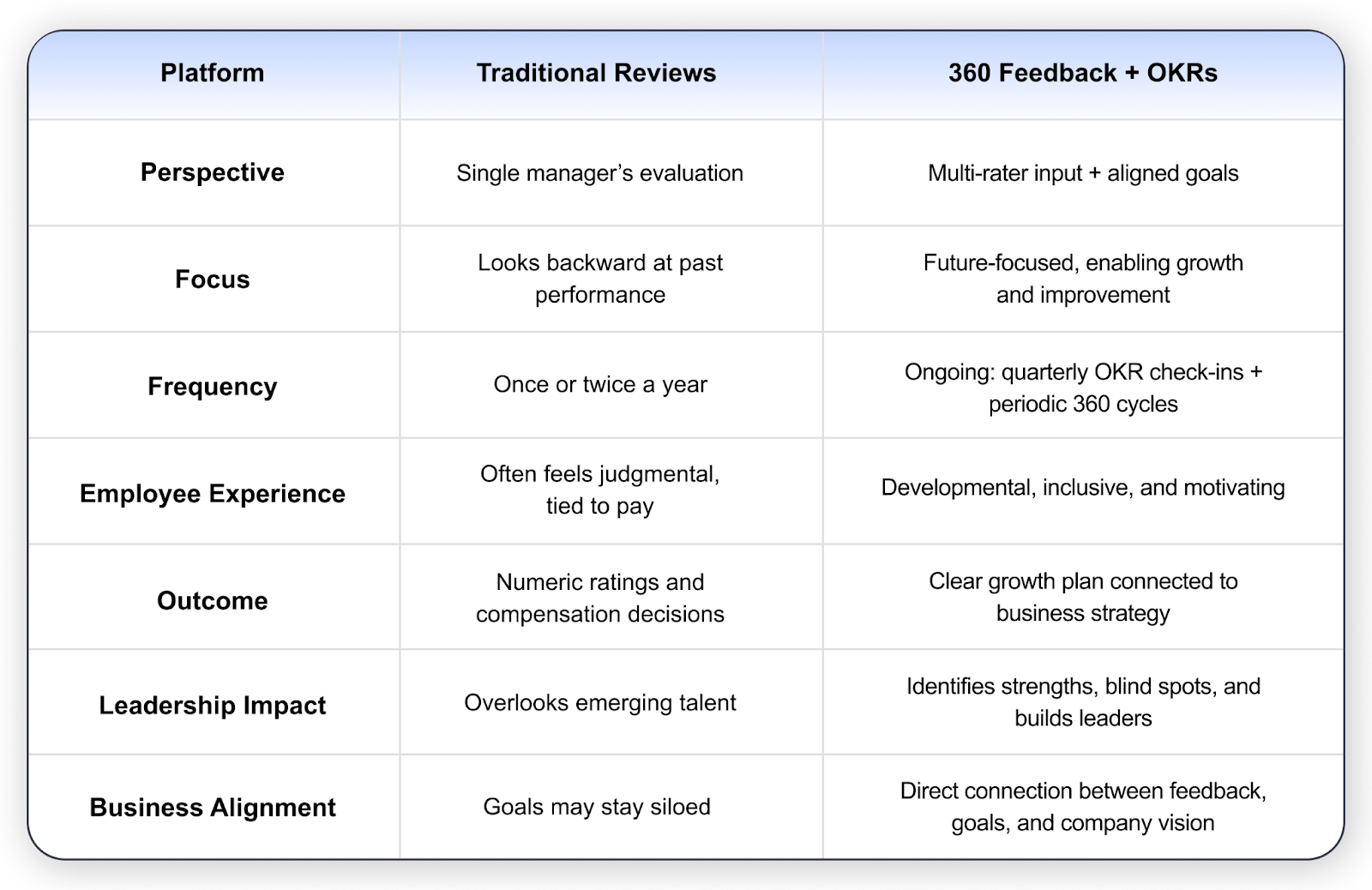360 degree feedback
360 Feedback + OKRs: Powerful Duo for Employee Growth
September 12, 2025
Discover how 360-Degree Feedback and OKRs redefine performance management. This strategic HR framework turns feedback into action, drives goal alignment, and builds a continuous growth loop for leadership development and employee performance

In boardrooms around the world, one conversation keeps resurfacing: How do we balance performance accountability with employee growth in a way that’s both scalable and human?
Traditional annual reviews are losing relevance. Today’s workforce, shaped by hybrid models, cross-functional collaboration, and rapid strategy shifts, demands something more dynamic. And that’s where the combination of 360-degree feedback and Objectives & Key Results (OKRs) comes into play.
Together, they form a growth engine, a continuous loop of insight and action that has the power to redefine how companies build leaders, drive alignment, and retain top talent.
Before we dive deeper, let’s pause and ask:What if performance management wasn’t just about tracking goals or giving feedback, but about creating a continuous growth loop?
- That’s exactly what happens when you combine 360-degree feedback with Objectives & Key Results (OKRs). But first, let’s unpack what each one really means.
What is 360-Degree Feedback?
Imagine seeing yourself through the eyes of your peers, managers, direct reports, and sometimes even clients 360-degree feedback is a multi-perspective review system that reveals how you're truly showing up across the organization. It’s not just about performance, it’s about perception, influence, and leadership potential.Done right, it becomes a mirror for growth, not a magnifying glass for flaws.
What are OKRs?
OKRs (Objectives and Key Results) are more than just goal-setting, they’re a strategic compass.They align individual ambition with organizational purpose, turning vague intentions into measurable outcomes.Think of OKRs as the GPS for your team: everyone knows the destination, the milestones, and how fast they’re moving.
Why 360-Degree Feedback Matters More in 2025
For experienced HR leaders, 360-degree feedback isn’t new. But its role has evolved. In a distributed and diverse workforce, it is no longer just a developmental tool, it’s a lens into organizational culture.
When done right, 360s help leaders answer tough questions:
- Are managers really empowering their teams, or just delegating tasks?
- Do employees see collaboration as a lived value or a buzzword?
- Where are the hidden leadership gems, those who may not speak loudest but make the biggest-impact?
A study published in the Journal of Management Development highlighted that 360 feedback builds lasting self-awareness and leadership capability when positioned as developmental rather than punitive. And U.S. companies that invest in multi-rater feedback often see faster leadership pipeline growth, an urgent need as over 70% of organizations report a shortage of ready-now leaders (DDI Global Leadership Forecast).
Why This Matters Now
The U.S. talent market is shifting fast. Gallup’s 2025 Workplace Report states only 21% of employees feel strongly aligned with their company’s goals. At the same time, burnout levels are at record highs, with many workers citing unclear expectations and a lack of growth as their top frustrations.
By integrating 360 feedback with OKRs, HR leaders can tackle both challenges head-on:
- Employees gain clarity (through OKRs).
- Employees feel heard and developed (through feedback).
This dual approach doesn’t just improve performance metrics with it strengthens engagement, retention, and culture, the very levers HR leaders are measured on.

Traditional Reviews vs. 360 Feedback + OKRs

Best Practices for 360-Degree Feedback
To make 360-degree feedback truly effective, HR leaders should focus on a few essentials:
- Secure leadership buy-in – Ensure managers and stakeholders champion the process.
- Define success clearly – Track outcomes like survey completion, action plans, and visible behavior change.
- Act on feedback – Follow-ups, coaching, and OKR alignment turn insights into real growth.
- Keep it relevant – Tie questions to core competencies and business priorities.
- Build accountability – Make employees and managers jointly responsible for using feedback.
- Encourage participation – A 360 works best when it’s consistent and inclusive.
Done well, 360 feedback isn’t just a survey, it becomes a growth engine that fuels employee development and business performance. (Atwater & Waldman,).
Closing Thoughts
For HRBPs, senior HR leaders worldwide & senior HR managers, the message is clear:
360 feedback without OKRs risks being insight without action.OKRs without feedback risk being goals without meaning.
But together? They form a continuous growth loop that can transform the employee experience and unlock organizational performance.
The next era of HR leadership in the world isn’t about choosing between development and accountability; it's about weaving them together. And the 360 + OKR framework is the playbook to make that happen.